If you’re starting your search for the market’s best dividend stocks, I have a suggestion:
Look for the best stocks that also pay dividends.
I know that sounds similar, but the emphasis matters. Sometimes, people seek out dividend stocks with yield in mind first, and quality second. While that can work out, it can also flame out spectacularly—after all, if a high payout is built on a shaky foundation, you might not receive that payout in perpetuity, and if that happens … well, it’s hard to imagine you’d love the stock you’re left with.
Instead, you want to primarily focus on high quality, for two reasons: 1.) It gives you a better chance of buying durable dividends that will keep delivering a steady (and even growing) stream of income over time, and 2.) it gives you a better chance of buying companies whose sales and profits will continue to improve, resulting in higher share prices over time, too.
If that sounds like a good plan to you, read on as I discuss the importance of dividends and dividend safety, followed by a look at 10 of the best dividend stocks through a high-quality lens.
Disclaimer: This article does not constitute individualized investment advice. These securities appear for your consideration and not as personalized investment recommendations. Act at your own discretion.
Featured Financial Products
Why Dividend Stocks?

Dividend stocks can do wonders for the long-term performance of your portfolio. These companies pay a regular flow of their profits directly back to shareholders, meaning you receive some sort of return—even when share prices aren’t cooperating.
Stocks that can both grow and pay dividends are the ultimate long-term stocks given just how much in additional returns they can generate over the long term.
Related: Direct Indexing: A (Tax-) Smarter Way to Index Your Investments
Here’s a look at the return someone could expect if they received just the price returns from the S&P 500 over the past 25 years:
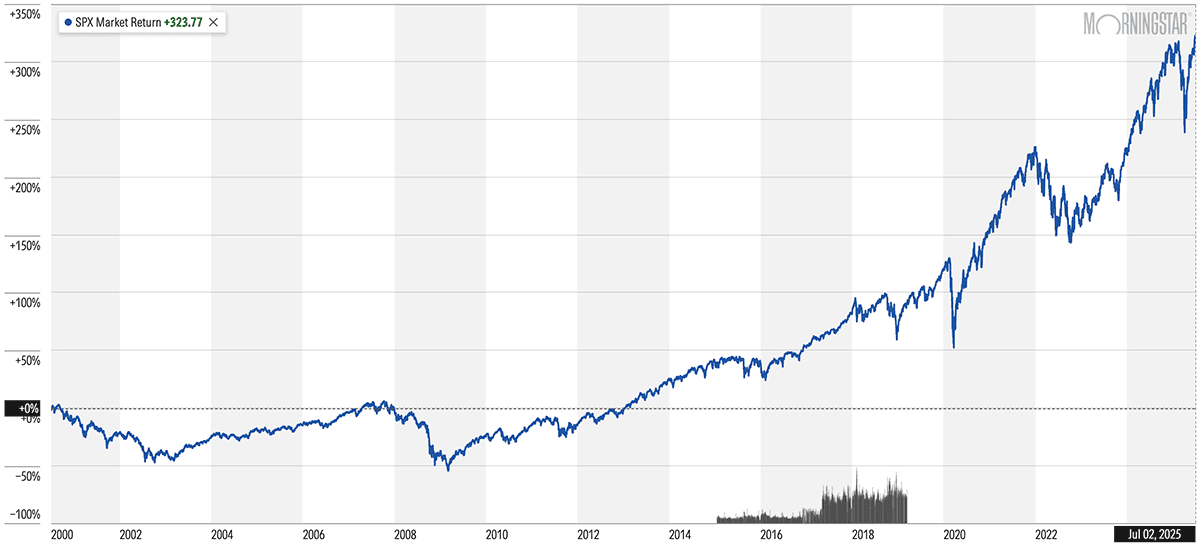
Now look at how much better the return is when you factor in dividends had you had reinvested those dividends back into the S&P 500 (returns illustrated by an S&P 500-tracking ETF; note that expenses are included in performance):
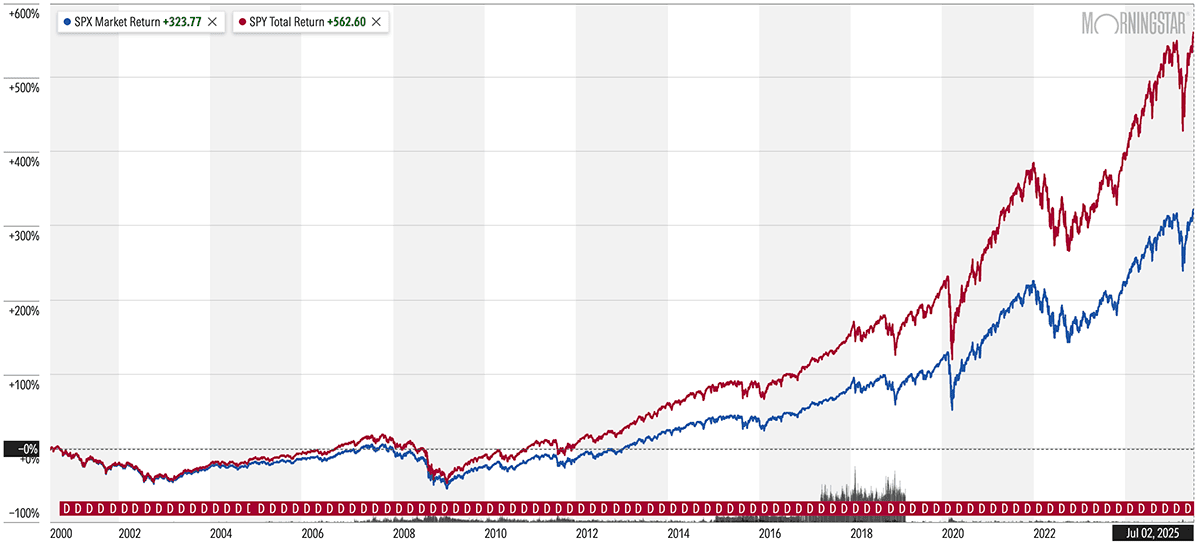
The price return is a little less than 325%. The total return (price plus dividends) is more than 560%!
Just like price return on stocks can be improved upon with dividends, though, a stock that pays dividends but doesn’t go anywhere isn’t exactly ideal, either. Thus, the best dividend stocks will provide both a steady baseline of income and provide you with the potential for meaningful price upside.
Dividend Yields (And Dividend Safety)
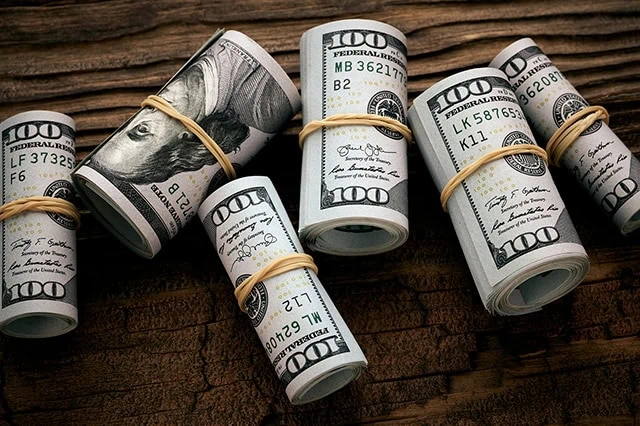
Dividend yield is a simple calculation—annual dividend / price x 100—that can mean a world of difference for investors, especially those reliant on income.
But dividend yield isn’t everything. Sometimes, stocks with high yields can look more attractive, but they’re actually flashing a warning signal that the dividend isn’t sustainable. You see, a company can get a very high annual dividend yield in two very different ways: the dividend growing very rapidly, or the share price falling very quickly.
For example, Alpha Corp., which trades for $100 per share, pays a 75¢-per-share quarterly dividend, or $3 across the whole year. It yields 3.0%. In a month, however, it yields 6.0%. Here are two ways that could have happened:
- Alpha Corp. doubled its dividend to $1.50 per share quarterly, good for a $6-per-share annual dividend. The share price stays the same. ($6 / $100 x 100 = 6.0%)
- Alpha Corp. kept its dividend at 75¢ quarterly ($3 annually), but its share price plunged in half to $50 per share. ($3 / $50 x 100 = 6.0%)
In one of those scenarios, Alpha Corp. has a very safe dividend. In the other one, Alpha’s dividend could be ready to implode.
So, if you’re sniffing out the best dividend stocks to buy for 2025, make sure you’re not just looking at yield, but also gauging a dividend’s safety. Among other things, you’ll want to look at payout ratio, which determines what percentage of a company’s profits, distributable cash flow, and other financial metrics (depending on the type of stock) are being used to finance the dividend. Generally speaking, the lower the payout ratio, the more sustainable the payout.
Related: 13 Best Long-Term Stocks to Buy and Hold Forever
How We Chose the Best Dividend Stocks to Buy

Before I started this article, I was video calling a colleague and joked, in a pseudo-philosophical voice, “What is a good dividend stock, anyways?”
But I was only partly kidding. What’s ideal to one investor might not fit the bill for another. Ultimately, though, I coalesced around safe dividends, with some capacity to grow, sporting above-average yields, paid by larger (and thus likelier to be more stable) companies. Specifically, they have to …
- Be in the S&P 500.
- Have a yield greater than 1.5%, to ensure they’re better than the overall market. Most of the stocks on here are around 2% or higher. (And if that’s too low a yield for you, I suggest you instead check out our list of high-yield dividend stocks, which have payouts of 5%-plus.)
- Have an earnings payout ratio below 70%. This is a generally safe level where there’s still at least some room for dividend growth, and the lower the payout ratio, typically the more growth potential there is. (Note: Free cash flow payout ratio is an even better metric, but screening data for this tends to be unreliable.)
- Have at least a consensus Buy rating according to analysts tracked by S&P Global Market Intelligence. S&P boils down consensus ratings down to a numerical system where anything less than 1.5 is a Strong Buy, 1.5 to 2.5 is a Buy, between 2.5 and 3.5 is a Hold, 3.5 to 4.5 is a Sell, and anything greater than 4.5 is a Strong Sell. In this case, I only included stocks with a 2.0 rating or less—so at least a pretty firm consensus Buy rating, if not an outright Strong Buy.
I also limited the energy sector to just two stocks. Energy companies were extremely overrepresented in the screen; most problematic is that several sport variable dividends that rise and fall based on available cash flow, which is largely tethered to the motion of energy prices. So a 3% yield today could be 1% in a year, 2% the year after, and so on. The rest of the list is populated with stocks that have more traditional dividend programs—regular payouts that typically only change when the company announces a hike.
The equities here are listed in reverse order of their consensus analyst rating, starting with the worst-rated stock and ending with the best-rated stock.
Related: 7 Best High-Dividend ETFs for Income-Hungry Investors
Featured Financial Products
Best Dividend Stock #10: Mondelez International

- Sector: Consumer staples
- Market cap: $89.5 billion
- Dividend yield: 2.7%
- Consensus analyst rating: 1.89 (Buy)
Mondelez International (MDLZ) is a prototypical defensive-minded, dividend-yielding consumer staples play that peddles its snacks to people in more than 150 countries worldwide. It’s responsible for brands including Oreo, Belvita, Tang, Cadbury, Philadelphia, Toblerone, and Halls. It’s the world’s top producer of cookies and crackers (they say “biscuits”; I decline) and No. 2 in chocolate.
There’s a reason “consumer staples” are often referred to as “consumer defensive.” That’s because while our consumption of certain products might ebb and flow with the economy, there are certain products we will hunker down and keep consuming no matter what. Sure, there are more true “needs” like basic produce, dairy, proteins, and personal-care items. But it applies to snacks too. After all, if the economy forces you to cut back on going out, you’ll still want treats at home—and price be darned, you probably won’t downgrade from Oreos to store-brand cookies unless you have no other choice.
Both Mondelez’s operational and stock performances have seemed downright agnostic for more than a decade, but MDLZ shares have perked up in 2025.
“The setup for the rest of 2025 and into 2026 looks promising, with cocoa-driven pricing actions tracking better than expected. Q2 should benefit from the Easter calendar shift, and productivity and cost savings remain solid,” says CFRA Analyst Arun Sundaram, who is among 19 Buy ratings on the stock. (MDLZ also has eight Holds and no Sells. “If cocoa costs ease, we expect MDLZ to reinvest any upside to strengthen its position heading into 2026.”
A reminder: Mondelez was previously Kraft Foods, but it adopted the new name after it spun off Kraft Foods Group–the company’s North American grocery business—in 2012. Its dividend was stagnant for a few years before that transaction, but it has grown at a pretty reliable 10% average annual rate after that, including an 11% improvement, to 47¢ per share, announced in July 2024. And between Mondelez’s consistent earnings growth and moderate 65% payout ratio, MDLZ should have the resources to continue its brisk dividend-growth pace.
Do you want to get serious about saving and planning for retirement? Sign up for Retire With Riley, Young and the Invested’s free retirement planning newsletter.
Best Dividend Stock #9: Bunge Global

- Sector: Consumer staples
- Market cap: $10.5 billion
- Dividend yield: 3.4%
- Consensus analyst rating: 1.89 (Buy)
Bunge Global (BG) is a leading agribusiness and food company, operating across the entire agricultural supply chain through its many subsidiaries. All told, its operations span roughly 23,000 employees across more than 300 facilities in over 40 countries.
Among other things, the U.S.-headquartered but Switzerland-incorporated firm is a leading global oilseed processor and producer of vegetable oils and protein meals. It sources, processes, and distributes grains such as soybeans, wheat, and corn. And it produces agricultural products such as fertilizers and sugars.
Bunge has been a “patience stock” for years thanks to lower margins on crush (the process that produces soybean oil and protein meal), as well as delays to its proposed mega-acquisition of Canadian grain handling business Viterra. However, shares have been on the mend in 2025 amid optimism over Renewable Volume Obligation (RVO) and the closing of its Viterra deal.
“[Bunge] reiterated ~$7.75 EPS guidance for 2025, which now includes more favorable Corporate and interest expenses offsetting slightly lower Agribusiness expectations,” says BMO Capital Markets Analyst Andrew Strelzik, who rates the stock at Buy. “While near-term operating environment remains challenging, fundamentals appear to be approaching an inflection with upcoming RVO, and risk/reward is favorable.”
Wall Street isn’t necessarily glowing over the stock, but the pros are overall more positive than not. BMO is among five Buys on the stock, versus four Holds and zero Sells.
Bunge, meanwhile, can pay investors at least a modest sum for their patience. The 3%-plus yield is 2 percentage points better than what you’ll get from the S&P 500. That dividend has grown by a decent 33% over the past four years, and it’s as safe as you could want it, with Bunge maintaining a conservative payout ratio of 35%.
Related: 9 Best Fidelity ETFs to Buy in 2025
Best Dividend Stock #8: Emerson Electric
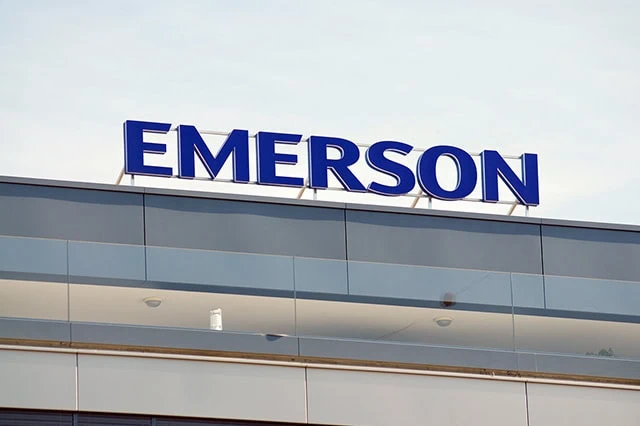
- Sector: Industrials
- Market cap: $78.5 billion
- Dividend yield: 1.6%
- Consensus analyst rating: 1.79 (Buy)
Emerson Electric (EMR) is an industrial-sector firm that was founded in 1890 and headquartered in St. Louis. Emerson has established itself as a global leader in technology and engineering, providing innovative solutions in process control, industrial automation, heating, ventilation, and air conditioning (HVAC), and more.
The company’s emphasis on technological advancement and diversified market penetration has been crucial in maintaining a competitive edge over the last 125-plus years. What once was a maker of electric motors and fans is now a global industrial-technology giant that produces not just tens of thousands of products, but even industry, automation, and operations management software.
Argus Research has noted for a while now that Emerson has been “divesting legacy segments and investing in new businesses that target energy security and affordability, sustainability & decarbonization, nearshoring, and digital transformation.” And indeed, in Emerson’s Q4 earnings release, management said it plans to transform the company into a pure-play industrial technology company.
“Since Emerson began realigning its portfolio, the company has achieved sales growth at the high end or above its target of 4%-7%,” says Argus analyst Kristina Ruggeri (Buy), who adds that a better valuation amid EMR’s underperformance in 2025 is yet another reason to snap up shares.
Ruggeri in a vast majority, as the pros have 21 Buys on EMR shares, greatly outnumbering five Holds and three Sells.
While its most recent payout increases haven’t been much to crow about, Emerson Electric is one of the best dividend stocks for payout growth. This industrial firm’s dividend track record spans 68 consecutive years, including a 1% uptick to its payout, to 52.75¢ per share quarterly, announced in November 2024. Meanwhile, the company pays out just 35% of 2025’s expected earnings—a conservative ratio that offers safety and room to grow.
Related: The 10 Best Index Funds You Can Buy Now
Best Dividend Stock #7: Cigna Group
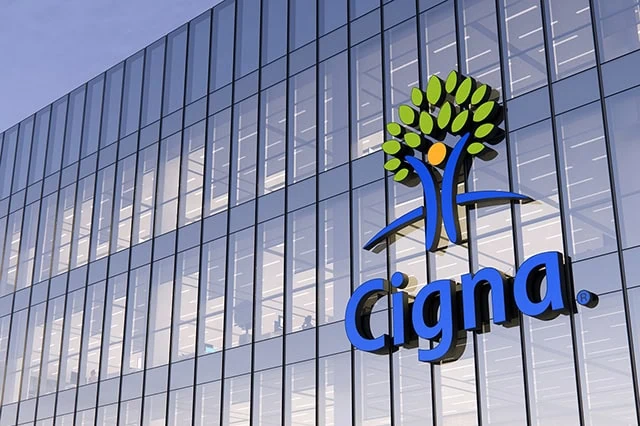
- Sector: Health care
- Market cap: $85.2 billion
- Dividend yield: 1.9%
- Consensus analyst rating: 1.76 (Buy)
Cigna Group (CI) is perhaps best known for the Cigna brand, which is one of America’s largest health insurers, offering health, dental, and other plans. But Cigna actually makes up less than half of Cigna Group’s revenues—60% come from its Evernorth Health Services unit, which includes its Express Scripts pharmacy and pharmacy benefit management businesses, Accredo specialty pharmacy, MDLive telehealth, and more.
One thing Cigna does not include is Humana—a possibility as far back as late 2023 when the companies discussed a merger. However, in November 2024, Cigna confirmed it would not be pursuing the rival insurer, so any purchase of Cigna would have to be on its own merits.
Fortunately, Wall Street seems to think there are plenty of those.
“In our view, Cigna remains one of the more attractive stocks in our space due to its diversified and stable earnings flow, solid growth avenues, and attractive valuations,” says Oppenheimer, which rates shares at Outperform. “The company’s service-based platform leaves minimal exposure to risk-products that are igniting volatility across the managed care space. Overall, we continue to favor Cigna due to its attractive portfolio and solid growth prospects within the volatile managed care space.”
Oppenheimer is one of 18 Buy-equivalent ratings on CI shares. Meanwhile, the Street has seven Holds and not a single Sell on the stock.
Unlike many of the dividend stocks on this list, Cigna doesn’t have a particularly illustrious dividend history. In 2004, the company cut its quarterly payout by 92%, to 2.5¢ per share (adjusted for its 3-for-1 stock split in 2007). Then in 2008, the company transitioned to 4¢ annual dividends, which lasted until 2021, when Cigna announced a new quarterly dividend of $1 per share. Since then, the company has raised its payout by another 51%.
Cigna certainly has more headroom for higher dividends going forward—the company’s current payout represents just 20% of 2025’s expected earnings.
Related: 7 Best Vanguard Dividend Funds to Buy
Featured Financial Products
Best Dividend Stock #6: Bank of America
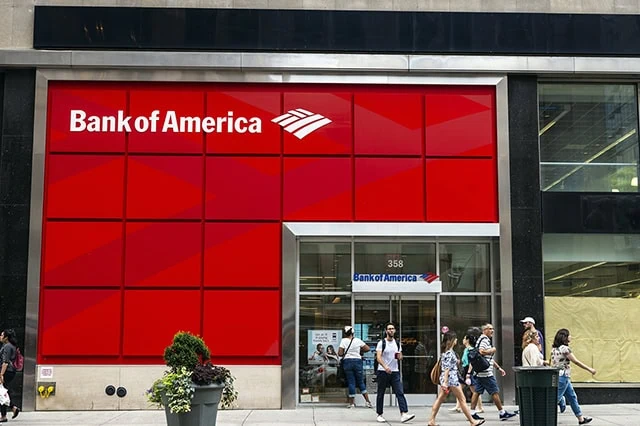
- Sector: Financials
- Market cap: $368.6 billion
- Dividend yield: 2.1%
- Consensus analyst rating: 1.54 (Buy)
Bank of America (BAC) is one of the world’s largest banks, serving roughly 69 million Americans through 3,800 branches and 15,000 ATMs across 39 states. However, BofA is much, much more than its consumer business—it also provides financial products and services for small and midsized businesses, large corporations, institutional investors, and even governments. Its offerings range from checking and savings accounts to commercial loans, trade finance, treasury management, and securities clearing.
BAC shares enjoyed a market-beating 35% return in 2024, but they’re enjoying more modest returns so far in 2025. You can chalk that up to economic skittishness and the absence (so far, anyways) of a much-hoped-for Trump-administration bounce in mergers and acquisitions (M&A), though that has improved of late as the Trump administration is beginning to retreat from some of its most aggressive tariff stances.
You can also blame, of all people, Warren Buffett. The Oracle of Omaha’s Berkshire Hathaway (BRK.B) sold roughly a third of its stake in Bank of America—a massive 352 shares—across 2024. KBW, which rates shares at Outperform, notes that the overhang remains, but “we are encouraged by the relative stability in Berkshire’s holdings of BAC since late in 4Q24. This is no guarantee regarding future activity, but it does appear that the company may be settling in on its ownership level rather than rushing to unwind its entire stake.”
And yet, the analyst community seems undeterred. BofA’s stock currently enjoys 21 Buy calls versus two Holds and one Sell, putting it among the best dividend stocks you can buy at this point in 2025.
“We believe BAC remains an attractive pick at this juncture given a stable starting point and seemingly pre-programmed grind higher on [net interest income] and associated operating leverage benefits on security reinvestment into today’s higher-rate environment,” says Oppenheimer, which rates the stock at Outperform. “We think the Fed will likely be constrained from dramatic rate cuts, thus we see BAC’s NII well positioned to grind higher sheerly on security portfolio repricing with upside if strong loan growth persists.”
As for the dividend? Bank of America has raised its cash distribution by 44% between 2020 and today—most recently, it announced an 8% hike, to 26¢ per share, effective as of the September 2024 payout. It’s also very well-covered at less than 30% of 2025’s expected earnings.
Related: 7 Best Fidelity Index Funds for Beginners
Best Dividend Stock #5: VICI Properties

- Sector: Real estate
- Market cap: $35.3 billion
- Dividend yield: 5.2%
- Consensus analyst rating: 1.54 (Buy)
VICI Properties (VICI) is a real estate investment trust (REIT) that specializes in gaming, hospitality, and entertainment properties. While you’re probably most familiar with its Vegas real estate, which includes Caesars Palace Las Vegas, MGM Grand, and the Venetian Resort Las Vegas, VICI actually owns 54 gaming properties and 39 other “experiential” properties—such as golf courses and Bowlero bowling alleys—across roughly two dozen states and Canada.
VICI and other gaming REITs are a way to invest in gambling/gaming with the potential for less volatility. That’s because their revenues aren’t directly driven by ups and downs in the business—they collect rent. So while a prolonged economic downturn, say, could weigh on operators’ ability to pay their bills, VICI is a bit more insulated from quarter-to-quarter issues.
Indeed, not only does VICI specifically have lease escalators that help ensure steadier growth going forward, but those escalators—at either the rate of inflation (via the consumer price index, or CPI) or 1.7% for non-CPI escalators—are above the industry average.
“We think the company has strong earnings visibility for 2025 and into 2026,” says JPMorgan’s North American Equity Research team, which rates VICI at Overweight (equivalent of Buy). “Its investment activity has been more varied as it diversifies into other areas of experiential real estate (i.e., youth sports, golf, wellness, bowling), and while these deals tend to be smaller than gaming transactions, they create more of a ‘flow’ of transactions.
“Outsized dividend yield, strong balance sheet, exposure to core gaming tenants and superior management are all supporting factors in our view,” adds Citi Research Analyst Nick Joseph (Buy). Citi and JPMorgan are among 21 Buy-equivalent ratings on VICI shares, which sports three Holds and zero Sells.
A reminder: REITs are structured differently than regular businesses. They receive significant tax breaks, but in return, they must pay out at least 90% of their taxable income back to shareholders in the form of dividends. And unlike regular stocks, with which we use profits or free cash flow to determine payout ratio, REIT dividend coverage is typically gauged by funds from operations (FFO), a metric of profitability that falls outside of generally accepted accounting principles (GAAP) standards.
FFO payout ratio standards are somewhat different, with 70% to 80% considered quite healthy. VICI? It has an adjusted FFO (AFFO) payout ratio of 75%. That should help it continue its short streak of dividend hikes, which included a 4% bump in the payout in late 2024 to 43.25¢ per share.
Best Dividend Stock #4: BlackRock
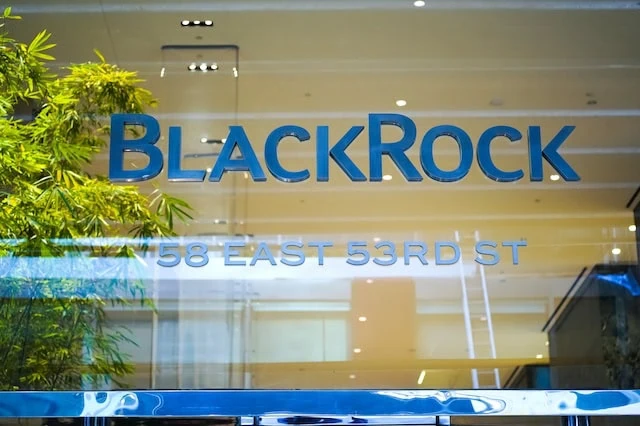
- Sector: Financials
- Market cap: $167.8 billion
- Dividend yield: 2.0%
- Consensus analyst rating: 1.53 (Buy)
BlackRock (BLK) is one of the world’s largest asset management firms, boasting nearly $12 trillion in assets across its many lines of business. Individual investors know it well for both its BlackRock mutual funds and closed-end funds (CEFs), as well as its iShares exchange-traded funds (ETFs). But it also manages money for institutional clients, including pension plans, foundations, charities, and insurance companies, among others.
With the exception of a few understandable hiccups (COVID, for instance), BlackRock has been in a broader consistent uptrend since the depths of the Great Recession. That has come alongside similar progression in both the company’s top and bottom lines.
It’s difficult to find any Wall Street pros with something negative to say about BLK. Shares currently enjoy 15 Buy calls versus two Holds and no Sells, and the analysts’ consensus for long-term earnings growth sits at a respectable 7% annually.
“We believe that BLK remains well positioned to deliver above-peer organic growth given its unmatched product breadth and distribution footprint (helped by its iShares franchise),” say Keefe, Bruyette & Woods analysts Aidan Hall and Kyle Voigt, who rate BLK at Outperform. “Also, its scale and demonstrated ability to generate operating leverage bodes well for future earnings growth and operating leverage.”
BlackRock has been a fount of dividend growth since the Great Recession, too. In the past decade alone, BLK has managed to average 10% annual dividend growth, though that pace has been slowing in recent years—its most recent hike, announced in January 2025, was a mere 2% bump to $5.21 per share. Still, a payout ratio around 45% should keep investors plenty confident in the dividend’s health and its ability to keep growing.
Do you want to get serious about saving and planning for retirement? Sign up for Retire With Riley, Young and the Invested’s free retirement planning newsletter.
Best Dividend Stock #3: Diamondback Energy

- Sector: Energy
- Market cap: $41.0 billion
- Dividend yield: 3.7%*
- Consensus analyst rating: 1.50 (Buy)
Energy businesses are typically referred to by their “stream.” Upstream companies search for and extract oil, gas, and other raw energy resources; midstream companies transport, store, and sometimes process those resources; and downstream companies refine these resources into final products such as gasoline, diesel, and natural gas liquids (NGLs).
Diamondback Energy (FANG) is an upstream firm—an independent oil and natural gas exploration and production (E&P) firm that operates “unconventional” onshore reserves in West Texas’ Permian Basin.
E&P companies are more beholden to commodity prices than the other “streams,” so as oil and nat gas prices go, so go their shares. Their differences boil down to operational efficiency, and FANG is among the best, according to Wall Street analysts, who as a group have a whopping 28 Buys on the stock, versus three Holds and no Sells.
“The company has done a notable job growing to one of the largest Permian pure-play names, including 2 recent Midland acquisitions, and continues to make strides in solidifying its position as the lowest cost Permian producer,” says Neil Dingmann, Truist Managing Director. “With growing free cash flow generation, FANG has continued to grow its base dividend while additionally paying down debt and maintaining production.”
“Takeaway capacity for natural gas out of the Permian, a chronic bugaboo for Permian E&Ps, is likely to be alleviated by mid-2026 to some extent by new pipeline construction, in our view,” says CFRA Analyst Stewart Glickman, who recently upgraded the stock to Strong Buy from Buy previously. “FANG is also continuing to grow through acquisition and its debt metrics look manageable.”
* Diamondback, like a growing number of energy companies, has a base-plus-variable dividend that provides a combination of flexibility for the company and security for investors. Specifically, it pays $1 per share quarterly in base dividends, and it will distribute additional variable dividends as cash flow allows. For instance, in August 2024, it paid out $2.34—a then-90¢ base dividend plus another $1.44 in variables. However, over the past three quarters, it has only paid out the base. Its trailing 12-month dividend, factoring in both base and variable dividends, is 3.7%. However, expected yield based on the regular quarterly dividend alone comes to a still well-above-average 2.8%.
Related: 9 Best Dividend Stocks for Beginners
Best Dividend Stock #2: NiSource

- Sector: Utilities
- Market cap: $18.5 billion
- Dividend yield: 2.8%
- Consensus analyst rating: 1.50 (Buy)
It shouldn’t surprise that one of the best dividend stocks for 2025 comes from the utility sector, which is known for steady operations and sustainable dividends.
NiSource (NI) is a natural gas and electric utility company founded in 1847 that serves more than 4 million customers in six states across the Midwest and East Coast.
In early 2025, NiSource hiked its quarterly dividend to 28¢ per share—up about 6% from its previous payout, and 40% better than what it was paying five years ago. That’s good news for investors, who typically buy stocks like NI for their stability and income potential rather than dramatic growth narratives.
Remember: NiSource and many other utilities are regulated, which means they must request permission to raise their prices and usually only do so by a couple percent every year or two. Plus, much of their money tends to be reinvested in infrastructure like electric lines and water pipes, or distributed as dividends to shareholders. So there’s usually not much growth to be had here.
Still, Wall Street is downright gushing as it pertains to NiSource, with 14 Buys versus one Hold and one Sell.
“This Midwestern utility has streamlined operations and has been outpacing peers in terms of cost savings,” says Argus Research Analyst Marie Ferguson (Buy). “The region has growing residential and manufacturing demographics and management is optimistic that its capital plans can boost its base rate by 8%-10% through 2029.”
There’s nothing exciting about buying a natural gas company and harvesting the dividends. But investors with little risk tolerance should love the chance to buy a low-priced stock that should net them reliable returns over time. Doubly so when that stock pays a dividend like NiSource’s, which at 60% of this year’s earnings is well-covered, especially compared to other utility names.
Featured Financial Products
Best Dividend Stock #1: Targa Resources
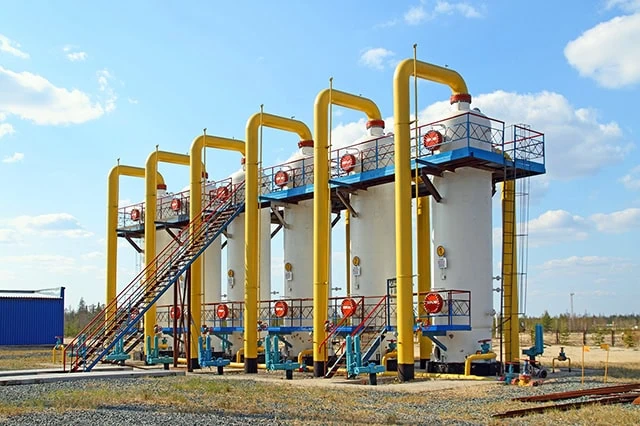
- Sector: Energy
- Market cap: $38.2 billion
- Dividend yield: 2.3%
- Consensus analyst rating: 1.41 (Strong Buy)
Targa Resources (TRGP) deals in the midstream energy market segment—alongside its subsidiary, Targa Resource Partners LP, it owns a wide array of gathering, processing, logistics, and transportation assets across numerous natural resource plays, including the Permian Basin, Bakken Shale, Anadarko Basin, and the Gulf of Mexico, among others. The Permian Basin is arguably Targa’s biggest growth driver; roughly 3 in 5 lower-48 U.S. shale rigs are located there, and about 80% of Targa’s natural gas inlet volumes are sourced from there.
Targa went public in 2010, peaked in 2014, cratered, then largely hovered for a few years after that. But after bottoming out during COVID, the stock has roared back to life and has since eclipsed its decade-ago peaks to hit all-time highs. Even after a doubling for TRGP shares in 2024, the analyst community remains wildly bullish: 20 Buys dwarf a pair of Hold calls and no Sells.
Much of this can be attributed to Targa’s positioning in the Permian.
“Targa has billions of dollars of largely fee-based projects in the hopper that we believe will add +1.7 billion cubic feet per day of gas processing capacity in the Permian and more than 1 million barrels per day of NGL transportation, fractionation, and export capacity, boosting earnings and [free cash flow] this year and next,” Truist analyst Neal Dingmann (Buy) recently wrote while upgrading his price target on shares, to $235 from $220 previously. “We believe the company will not only likely continue to accelerate the projects, but most will be highly utilized essentially out of the gate quickly boosting results.”
Energy infrastructure stocks are a different breed. Many of them are master limited partnerships (MLPs), which are required to return a majority of their income to unitholders (shares in MLPs) in the form of distributions (dividend-like payments to shareholders that have different tax consequences). Targa is technically a corporation, so it pays dividends like a traditional stock. But like an MLP, the proper metric for its payout ratio is distributable cash flow (DCF) … and by that gauge, Targa’s quarterly distribution is well-covered, indeed, at less than 20% of DCF projections for 2025, even after the company’s recent 50% hike to 75¢ per share.
Want to talk more about your financial goals or concerns? Our services include comprehensive financial planning, investment management, estate planning, taxes, and more! Schedule a call with Riley to discuss what you need, and what we can do for you.







